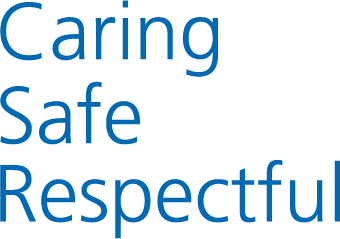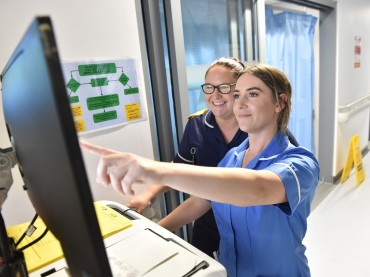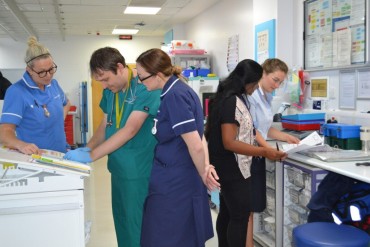Introduction
The information contained within this leaflet covers several devices that we commonly care for within the community, these are known as venous access devices. They are used for intravenous (IV) treatment. Your healthcare professional will advise you what device you have and record it within this leaflet.
Venous Cannula
A venous cannula is a small flexible plastic tube inserted into a vein, usually in the back of your hand or arm. It can remain in place for 72-96 hours.
Midline
A midline is a long, thin, flexible plastic tube, inserted into a large vein in the upper arm. A midline can be a short-term or long-term device, they can stay in place for 28 days or up to one year (depending on the manufacturer).
Peripherally Inserted Central Catheter (PICC)
A PICC line is very similar to a midline, however it is longer, and it can stay in place for one year or longer (depending on the manufacturer). It is secured by a fixation device, to help prevent the tube dislodging.
Hickman Line
A Hickman line is a long, thin, flexible tube inserted through your chest into a large vein. There is a small cuff under the skin to help prevent the tube dislodging. It can stay in place for one year or longer (depending on the manufacturer).
Totally Implantable Venous Access Device (TIVAD)
A TIVAD is a long-term device inserted under the skin, usually on the chest, into a large vein. To use the device, a special needle is inserted through the skin.
Caring For Your Device
Your nursing team will let you know how they plan to care for your device, it is also important for you to look after your device. This includes:
• Keeping the device and dressing clean and dry – your healthcare professional can discuss waterproof covers with you. This is not applicable if you have a TIVAD.
• Wear loose fitting clothing to avoid accidentally catching your device.
• Practice good hand hygiene to help prevent an infection. Your device must only be touched after hand hygiene has been performed.
• Observe for any complications – if you experience any, please get in touch with your team.
Hand Hygiene
The most effective barrier against the spread of bacteria, viruses and dirt from spreading is frequent hand washing with soap and warm water or using alcohol hand rub.
When should I clean or sanitise my hands?
• Prior to eating, drinking, and taking medicines.
• After visiting the toilet – Always wash with soap and water.
• After coughing and sneezing.
• When hands are visibly soiled – Always wash with soap and water.
• After contact with others
Best Practice: How to hand wash step by step images
Steps 3-8 should take at least 15 seconds.
1. Wet hands with Water.
2. Apply enough soap to cover all hand surfaces
3. Rub hands palm to palm
4. Right palm over the back of the other hand with interlaced fingers and vice versa.
5. Palm to palm with fingers interlaced.
6. Backs of fingers to opposing palms with fingers interlocked.
7. Rotational rubbing of left thumb clasped in right palm and vice versa
8. Rotational rubbing, backwards and forwards with clasped fingers of right hand in left palm and vice versa.
9. Rinse hands with water
10. Dry throughly with towel
11. Used elbow to turn off tap
12. and your hands are safe.
Best Practice: How to handrub step by step images.
1. Apply a palmful of the product in a cupped hand and cover all surfaces
2. Rub hands palm to palm
3. Right palm over the back of the other hand with interlaced fingers and vice versa
4. Palm to palm with fingers interlaced
5. Back of fingers to opposing palms with fingers interlocked
6. Rotational rubbing of left thumb clasped in right palm and vice versa.
7. Rotational rubbing, backwards and forwards with clasped fingers of right hand in left palm and vice versa.
8. Once dry, your hands are safe.
Complications
There are several complications that may occur when you have a venous access device. These may include:
• Infection – observe for signs of redness, warmth, pain, swelling, drainage at the insertion site and a high temperature (fever).
• A blood clot – it is possible for one to form in your vein at the end of the line. If this happens you may experience shortness of breath and chest tightness. Observe for signs of swelling, redness and tenderness in the hand, arm, and chest area into the neck.
• Damage to your device – your device may dislodge and bleed, apply immediate pressure to the bleeding to help it stop and contact your team.
If you experience any complications, please get in touch with your team immediately. If you cannot get in touch with them, please contact 111 or 999 if necessary.
Your Device
Type of Device
Venous cannula □
Midline □
PICC □
Hickman □
TIVAD □
Date inserted: _______________
Useful Contact Details
If you have any concerns or questions, please contact the team caring for your device on: _______________________________________________
If it is outside of their working hours or you are unable to gain contact with them, please contact 111 or 999 if necessary
Leaflet Number PL/955
Author Charles Peil
Review Date 01/12/2027



